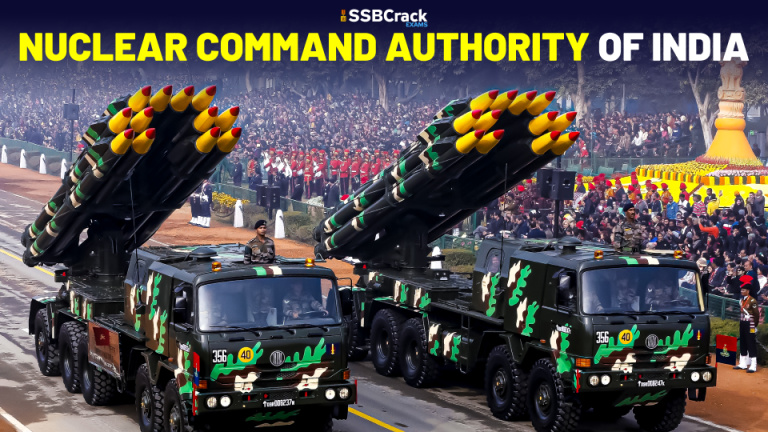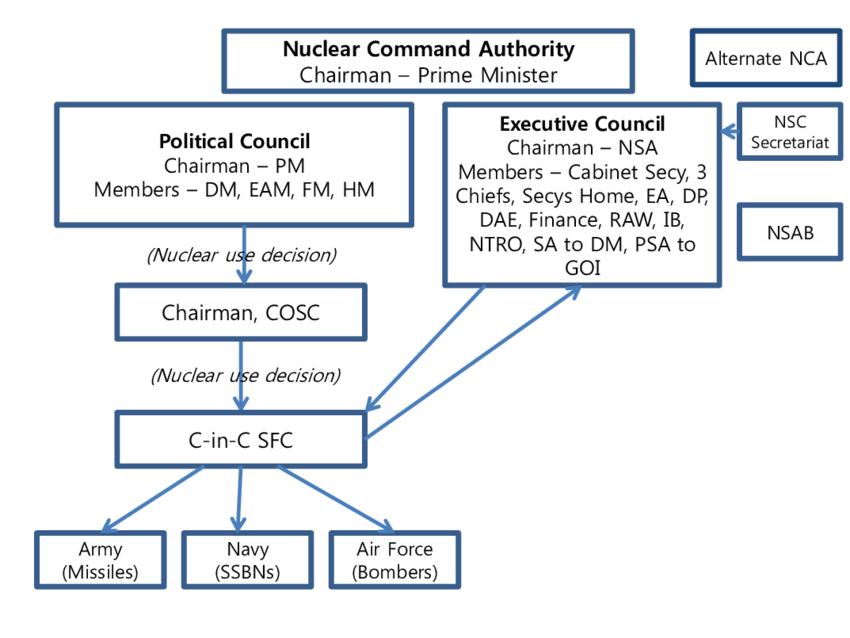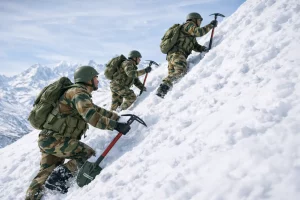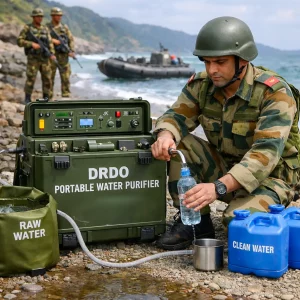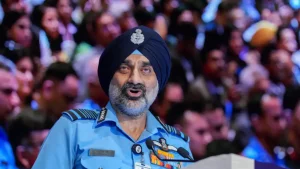The authority in charge of making command, control, and operational decisions regarding India’s nuclear weapons programme is known as the Nuclear Command Authority (NCA). It consists of an Executive Council led by the National Security Advisor and a Political Council led by the Prime Minister of India.
History of Nuclear Command Authority
India carried out its first nuclear test on May 18, 1974, under the code name Smiling Buddha. Since then, India has undertaken a second set of tests at the Pokhran test site in the Indian state of Rajasthan. One of these tests, code-named Operation Shakti, involved a thermonuclear device. At least 10 nuclear reactors, uranium mining and milling sites, heavy water production facilities, a uranium enrichment facility, fuel manufacturing facilities, and vast nuclear research capabilities are all part of India’s extensive civil and military nuclear programme.
Even though India has not made any formal declarations regarding the extent of its nuclear arsenal, assessments from several nations suggest that India may possess between 150 and 300 nuclear warheads.
Also Read: India Expanding Its Nuclear Arsenal From 156 To 160 Warheads Claims SIPRI
Structure of Nuclear Command Authority
The Cabinet Committee on Security (CCS) established the NCA’s Political Council and Executive Council on January 4, 2003. Its headquarter is in New Delhi. The Political Council considers the Executive Council’s recommendation before approving a nuclear strike when it is judged essential. The Prime Minister preside over the Political Council while the National Security Advisor (NSA) serves as chair of the Executive Council. This mechanism was put in place to guarantee that Indian nuclear weapons are kept firmly under civilian control and that a sophisticated Command and Control (C2) system is in place to stop any accidental or unauthorised use of them.
Strategic Forces Command
The Strategic Forces Command, which is in charge of managing and administering the tactical and strategic nuclear forces, is responsible for putting the NCA’s instructions into action. The Commander in Chief of the Strategic Forces Command (SFC) will control, manage and administer the nuclear forces. In the present dispensation, it is unclear if the SFC would function under the Chiefs of Staff or the Executive Council.
The NCA might be viewed as the foundation for the creation of its strategic nuclear forces’ infrastructure and Command and Control (C2) and Indications-and-Warning (I&W) systems.
Delivery of Weapons
- Delivery mechanisms for Indian nuclear weapons are now in an unknown and highly classified state. India has created and tested nuclear bombs that could be launched on Prithvi and Agni missiles, but it is still unknown how far along it is in operational readiness.
- The 150 km range Prithvi-1 and 250 km range Prithvi-2 were first tested by India in 1988 and 1996, respectively.
- By the early to mid-1990s, the Prithvi missiles had been incorporated into the Indian armed forces.
- The Agni missiles were developed slowly by India. It initially tested the Agni technology demonstration in 1989, the two-stage Agni-2 with a 2000 km range in 1999, the single-stage Agni-1 with a 700 km range in 2001, and the three-stage Agni-3 with a 3,000 km range in 2006.
- Agni-4 with a range of 4,000 km in 2011 and Agni-5 with an estimated range between 5,000 and 8,000 in the year 2012.
- The successor, Agni-6 is said to be under development with an speculated range of 10,000 km.
Also Read: Unfolding The Relevance Of AGNI Series Missiles From AGNI I To AGNI VI [Fully Expalined]
All of these missiles are lethal, and they have already been tested for compatibility in the war field. Furthermore, India had certain nuclear weapons, particularly the Agni, before these missiles became available, it is likely that the country’s current nuclear arsenal includes weapons that can be delivered by aeroplanes. The Dassault Rafale, a nuclear attack-capable aircraft, is flown by the Indian Armed Forces. There are no open-source records indicating which, if any, of these aircraft are fitted to drop atomic weapons by air. The following aircraft classes could be employed for this objective. Since the MiG-27 and Jaguar were initially intended to carry out ground attack missions, delivering nuclear weapons would only necessitate minor modifications.
In addition, the Indian Air Force uses a number of other outdated and less effective ground-attack aircraft that would appear to be less plausible candidates for delivering nuclear weapons. Originally built for air-to-air combat, the MiG-29, Sukhoi Su-30 MKI, and Mirage 2000 may be adapted to deliver air-dropped nuclear warheads. The SLBM/SLCM Sagarika will be used to deliver nuclear bombs from an Arihant class submarine.
Also Read: Major Difference Between Brahmos V/S S400?
India’s Nuclear policy
- No First Use has been reinterpreted by asserting that it would not apply if the adversary employed CBWs (Chemical/Biological weapons), even though many aspects of the Draft Nuclear Doctrine published in 1999 have been kept. This seems incredibly implausible given the context of South Asia.
- Given the unstable environment in South Asia, there are concerns regarding how India would respond if it were attacked with CBWs by a Non-State Actor.
Although some might question India’s stance in keeping its nuclear programme, a little unclear and to some extent, hideous, it must be taken into consideration that some extent of transparency is always required for a better deterrence. India has its policy of no first use which prevents it from any misuse, also India is a responsible state.
So, this is all about the Nuclear Command Authority, which takes all the decisions regarding India’s nuclear weapon programme. Follow SSBCrackExams to read more such articles. Jai Hind!
To join Indian Armed Forces as an Officer and crack the SSB interview, You can join our SSB interview live classes batch and we recommend you to Enroll SSB INTERVIEW ONLINE COURSE. Trusted by thousands of defence aspirants.
